Goodbye, incandescent light bulb. You had a heck of a run before the government decided you wasted energy and outlawed you out of existence.
The bulb remains one of the greatest inventions in human history. By sending an electrical current through a thin filament that resides inside a bulb to keep the oxygen out, light is produced. Until Thomas Edison improved them, the pre-1870 bulbs were finicky, noisy and burned out fast. He introduced a carbonized bamboo filament that made the light bulb cheap, bright and able to last up to 1,200 hours.
We’d been pretty much using Edison’s light-bulb technology since 1870, so why did the federal government ban it Aug. 1? As electricity passes through the filament in the old bulb, you see, the filament gets hot and produces light. But heat is wasted energy. And since our electric energy comes from power plants, most of which still burn coal to produce it, that means your grandpa’s old light bulbs are bad for the environment.
Edison’s once-cherished bulb has been on the endangered species list for years. In 2007, reports Forbes, President Bush’s Energy Independence and Security Act “called for household light bulbs to have ‘about 25% greater efficiency.’” Then in 2017, the Obama Administration added two regulations that effectively would have phased out the making and sale of incandescent bulbs by January 2020. President Trump gave the bulb new life by blocking Obama’s regulations, but then the Biden Administration blocked Trump’s block.
Therefore, the incandescent light bulb — with the exception of appliance lights and bug lights — will slowly disappear from our daily lives.
Some conservative people have made a big fuss about the government giving Edison’s light bulb the death penalty, but, if truth be told, it’s not the end of the world for most people. Sure, consumers will have fewer choices and will have to spend more upfront to buy long-lasting LEDs. But LED bulbs have improved so much in recent years that half of U.S. households use them, according to the 2020 Residential Energy Consumption Survey.
I stopped using incandescent bulbs for indoor lighting a few years ago. I replaced every bulb with LEDs. I also replaced the 500-watt halogen spotlights that could bake a turkey with commercial-grade LED spotlights. It cost plenty to make the changes, but I cut my electric bill in half. But the point here is, in my case, it was my choice to switch to LEDs, not the federal government’s.
Unfortunately, not being able to choose our light bulbs is just one part of the federal government’s war on appliance choice, according to MSN. The Biden Administration’s water- and energy-saving zealots are now demanding that dishwashers use about half as much water as they currently use per load — which is how the Clinton Administration wrecked clothes washing machines in 2001.
Mandating stringent efficiency standards for water heaters, furnaces, refrigerators, air conditioners and portable generators — standards that some argue are impossible to meet and that only make appliances work less efficiently — is the worst kind of government meddling. If you prefer the free market and want geniuses, such as Edison, to come up with new solutions and more-efficient products for your kitchen, laundry room and furnace room, as I do, then you’re out of luck.
The primary inventors these days are the busybody Washington bureaucrats dreaming up a spate of ever-nuttier appliance regulations.
Copyright 2023 Tom Purcell, distributed exclusively by Cagle Cartoons newspaper syndicate. Purcell is a humor columnist. Email him at Tom@TomPurcell.com.



